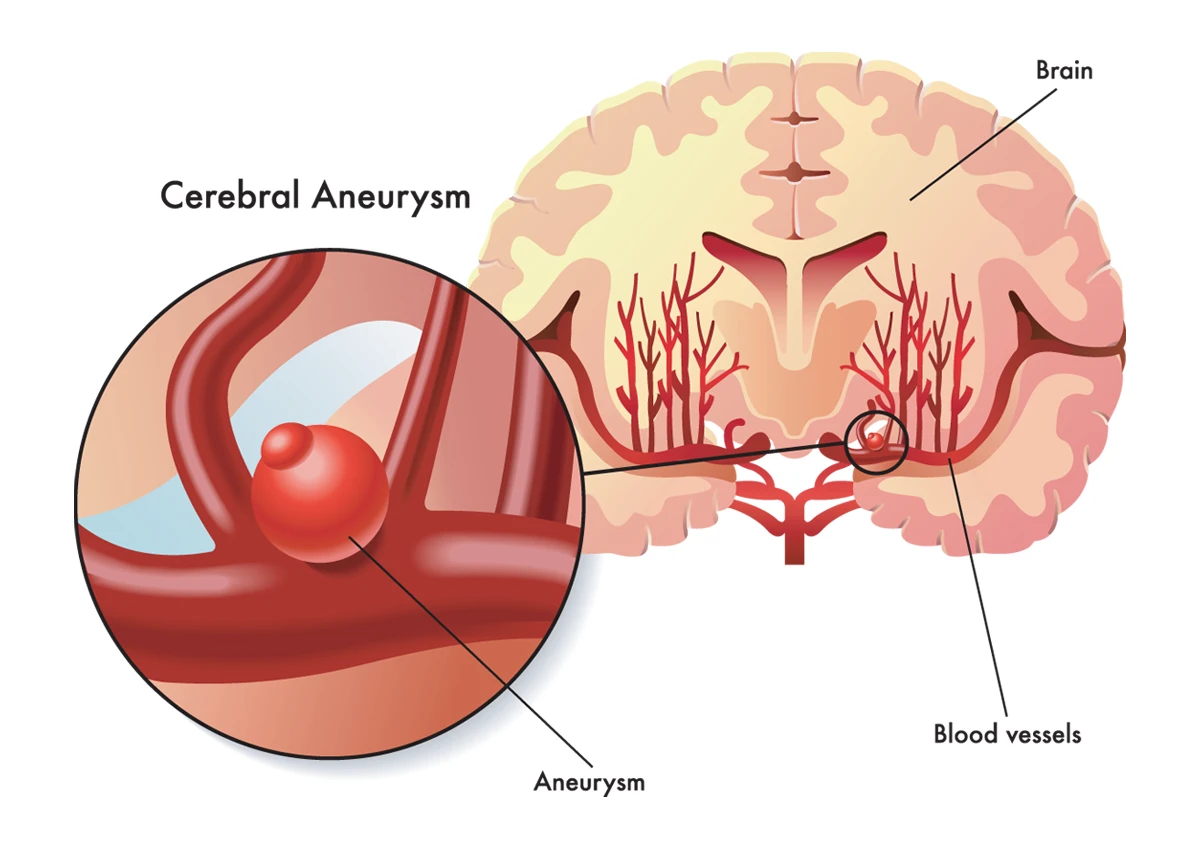Brain aneurysm
Find a neuro specialistA brain aneurysm, also called a cerebral aneurysm, occurs when a blood vessel in the brain balloons outwards due to a weak spot in the wall. Think of it as a weakened section in a balloon, causing it to bulge like a small bubble.
If an aneurysm enlarges or ruptures, the consequences can be severe. Much like a bursting balloon, a ruptured aneurysm can lead to life-threatening bleeding in the brain, necessitating immediate medical attention.
Providers often detect brain aneurysms before they rupture, enabling timely intervention to prevent complications. Recognizing the signs of a brain aneurysm and understanding preventive measures is crucial.
What is a brain aneurysm?

A brain aneurysm is a ballooning blood vessel, as shown in the image above.
Aneurysms in the brain typically emerge over time due to varied factors such as elevated blood pressure, the natural process of aging, genetic predispositions or previous trauma.
When a brain aneurysm experiences leakage or ruptures, it results in a brain hemorrhage, also known as a subarachnoid hemorrhage. This occurrence resembles a stroke, wherein blood pours into the space between the skull and the brain's protective layer.
Although brain aneurysms are relatively common, they typically remain asymptomatic and pose no immediate threat. In fact, most cases are incidentally detected during routine screenings for unrelated health issues.
Brain aneurysm symptoms
Brain aneurysms often develop without noticeable symptoms until they reach a certain size or undergo leakage or rupture.
Signs indicating a leaking or ruptured brain aneurysm include:
- Loss of consciousness
- Nausea and vomiting
- Pain above one eye
- Seizures
- Sensitivity to light
- Sudden, severe headache
- Stiff neck
- Vision problems
If you experience any of these symptoms, particularly a sudden and severe headache, it's crucial to seek immediate medical attention.
Prompt intervention can significantly impact the treatment and recovery outcomes associated with brain aneurysms.
Diagnosis of a brain aneurysm
When diagnosing a brain aneurysm, your provider will perform a thorough physical examination and discuss your symptoms. They'll ask about any headaches, seizures or other relevant symptoms you've experienced, as well as potential risk factors such as high blood pressure, smoking habits or a family history of aneurysms.
To obtain detailed images of your brain that may reveal evidence of a bulge or bleeding, your doctor may employ imaging tests such as a CT scan or MRI. These diagnostic tools play a crucial role in identifying and assessing the presence of a brain aneurysm, allowing effective treatment planning.
Brain aneurysm treatment options
When you’re diagnosed with a brain aneurysm, your doctor will initiate treatment to prevent its rupture or further enlargement, considering factors such as the aneurysm's location, size and your overall health.
For unruptured brain aneurysms detected through tests or scans, two primary treatment options are typically considered:
- Observation: If the aneurysm is small and asymptomatic, your doctor may opt for frequent monitoring through regular imaging scans. This approach is favored when the risks associated with treatment outweigh those of an aneurysm rupture.
- Medication: Certain medications may be prescribed to manage symptoms related to aneurysms, such as pain relievers for aneurysm headaches or drugs to control blood pressure. In cases of a ruptured aneurysm, medications might be administered to prevent complications like vasospasm (blood vessel narrowing).
If repair or surgery is necessary, your care team may adopt one of these approaches:
- Surgical clipping: In this procedure, a neurosurgeon makes an incision in the skull to directly access the aneurysm. A metal clip is placed across the aneurysm's neck to halt blood flow, effectively sealing it off from the main blood vessel.
- Endovascular therapy: This minimally invasive procedure involves accessing blood vessels via a catheter inserted into an artery, usually in the groin, and guiding it to the brain's aneurysm site. Coils, stents, or other devices are then inserted to block off the aneurysm and prevent blood flow into it, reducing the risk of rupture.
Following treatment, particularly in cases of a ruptured aneurysm, rehabilitation may be essential to help you regain lost function and recover from any neurological deficits resulting from the aneurysm or its treatment. Rehabilitation measures may include physical therapy, occupational therapy or speech therapy, tailored to the individual's needs for recovery.
Get care
We help you live well. And we’re here for you in person and online.